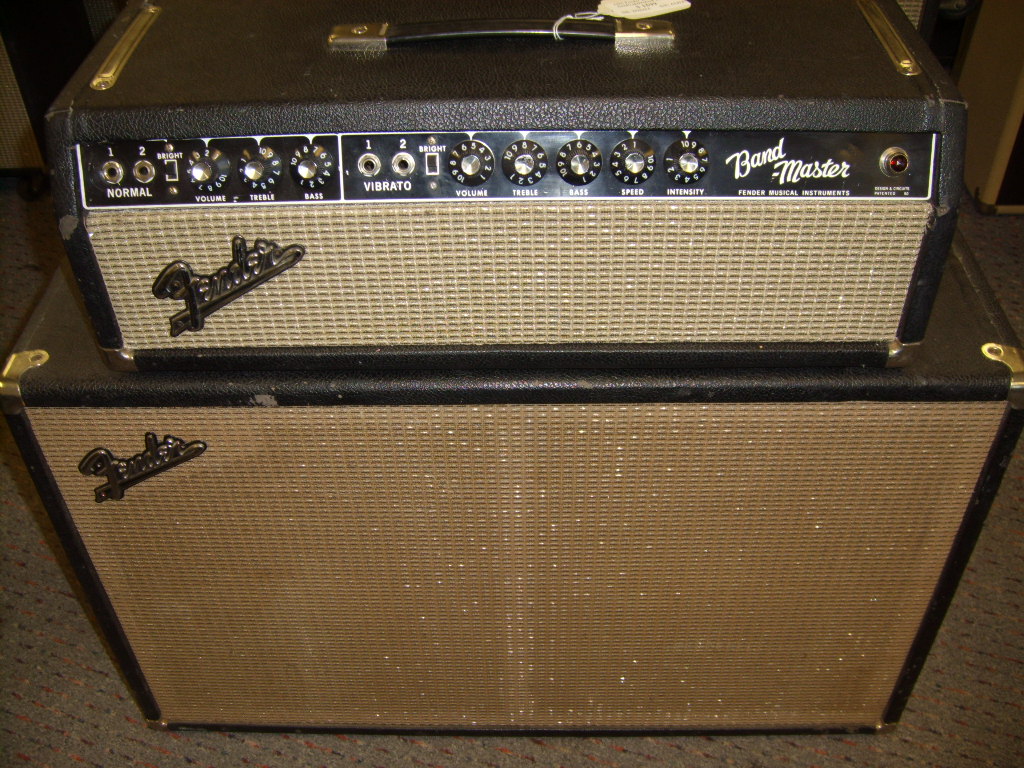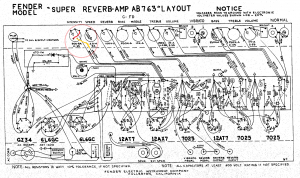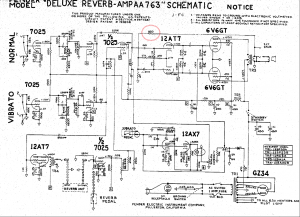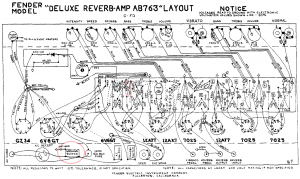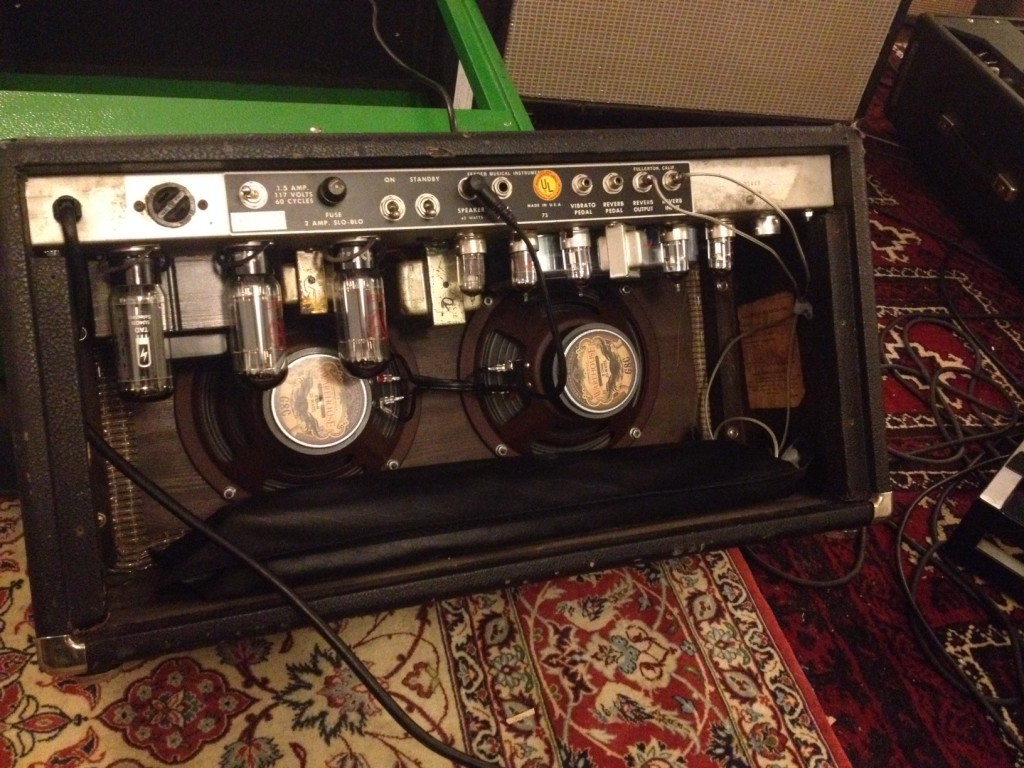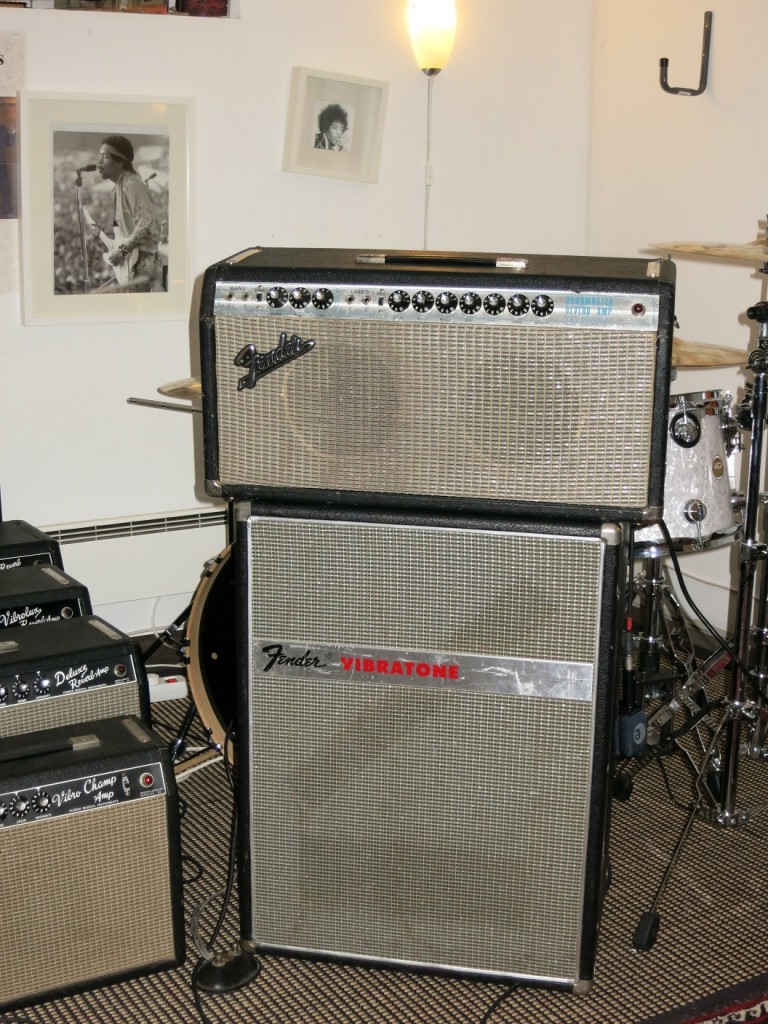Production years:
- 1963 -1967 blackface Bandmaster circuits AB763
- 1968 -1975 silverface Bandmaster circuits AA763, AB763, AC568, TFC-5005
- 1968 -1978 silverface Bandmaster Reverb circuits AA768, AA568, AA1069, or TFL5005
- 1988 -1980 silverface Bandmaster Reverb Master volum 45w and 70w
Tube layout
AA763/AB763 Blackface Bandmaster (Seen from behind, V1 is to the right side):
- V1 12ax7 = Preamp normal channel
- V2 12ax7 = Preamp vibrato channel
- V3 12ax7 = Vibrato
- V4 12at7 = Phase inverter
- V5 6L6 = Power tube #1
- V6 6L6 = Power tube #2
Silverface Bandmaster Reverb:
- V1 12ax7 = Preamp normal channel
- V2 12ax7 = Preamp vibrato channel
- V3 12at7 = Reverb send
- V4 12ax7 = 1/2 Reverb recovery and 1/2 gain stage for vibrato channel
- V5 12ax7 = Vibrato
- V6 12at7 = Phase inverter
- V7 6L6 = Power tube #1
- V8 6L6 = Power tube #2
- V9 GZ34/5U4GB = Rectifier tube
Summary
The Bandmaster came with many different circuits during the blackface and silverface eras. The blackface head had a diode rectifier, one normal channel and a vibrato channel with no reverb. The silverface Bandmaster amps got a 5U4GB tube rectifier and the vibrato channel got reverb. Hence, the name “Bandmaster Reverb”. Due to this the silverface Bandmaster Reverb is less powerful, has less attack and breaks up earlier than the blackface Bandmaster. As usual the later silverface models were modified to become cleaner and more powerful. The 70W model from 1978 with master volume and push/pull boost had a huge power transformer and big filter caps. It reminds us more of a classic 80w Twin Reverb than a Bandmaster Reverb, and it shared its circuit design with the Pro Reverb and Super Reverb at that time.
The silverface Bandmaster Reverb is a typical ab763 amp and shares basic circuit design with the Super Reverb, Deluxe Reverb, Twin Reverb, Vibrolux Reverb, Pro Reverb and Twin Reverb. The main differences between these amps are transformer size, filter caps size and output/speaker impedance. Yes of course some have the mid knob and bright switch while others don’t. All these ab763 amps with reverb has the gain stage in the reverb recovery circuit which the non-reverb amps don’t have. The reverb amps will start to break up around 4-5 on the volume knob while the non-reverb amps stay clean to approx 6-7. This is caused by the lack of gain stage in the reverb recovery circuit which contributes to tube distortion and compression in the preamp section when the amp is pushed. Not only is there more action in the preamp section, the silverface Bandmaster Reverb also has less attack and less clean headroom in the power amp section due to the tube rectifier. The Bandmaster Reverb head is therefore quite similar to the amps in the Pro Reverb and Vibrolux Reverb, just without the speakers.
Let’s study the blackface Bandmaster AB763 and blackface Bassman AA864. They are similar in the way that both are clean sounding with just one 12ax7 tube in the preamp stage (vibrato ch in bandmaster and normal channel in bassman). The vibrato channel in the Bandmaster is even more clean than the Bassman because of the vibrato circuitry loading the signal chain and reducing the gain level in the preamp section. Hence, the AA864 Bassman normal channel has more preamp “juice” and reaches the sweet spot at an earlier volume knob setting. The Bassman has a slightly bigger output transformer resulting in a firmer tone and more attack. A smaller output transformer will introduce sag and compression in the power amp section. The blackface Bandmaster is therefore ideal for those who look for a pure Fender clean sound without making ones ears bleed.
The blackface and silverface Bandmasters are medium/big sounding amps with a flexible speaker impedance of 4 ohm, allowing anything between one and four speakers (8 ohm each) to be connected via the main and/or external speaker jack. This makes it possible to adapt to small and big stages and gigs just by configuring the speakers.
Most of the maintenance and mod tips below will make the amp break up earlier, reaching the sweet spot at a lower volume. Tube mods (pulling V1 out and a 12ax7 PI) will take you a long way, and if you also invest in implementing the tremolo disconnect mod, you may get a fatter, warmer and fuller tone at practice volumes. Unfortunately does the diode rectifier not offer any options for rectifier tube swaps to select among different plate voltages, clean headroom levels and sag characteristics.
You’ll need schematics to implement some of these mods. http://www.ampwares.com/fender.asp. We usually start with explaining a mod from a functional perspective where we relate to components in the logical schematics diagram. Finally we point out location of components in the physical layout diagram.
Five fundamental tricks to create the holy grail of Fender tone
Here is a video demonstrating the effects of some of the mods and tricks described here. To see embedded text comments, go to video on Youtube.
Speakers
The Bandmaster’s 2×12″ speaker cabinet was from the Fender factory loaded with either Jensen C12n or Oxford 12T6. Personally we favor the Jensen C12n for their natural and transparent “Fendery” tone and, most importantly, for not being to bright and harsh. The C12n sounds very punchy, wide and deep in a 2×12″ cabinet.
See page How to select speakers for speaker recommendations.
12AY7 or 12AT7 as preamp tubes – Less preamp gain.
If you want cleaner and spankier preamp distortion characteristics, you may replace the V1 or V2 12AX7 preamp tube with 12AT7 and 12AY7. These tubes have different frequency responses than 12AX7, particularly when distorting. People describe these tubes to have less harsh and buzzy distortion. This mod does not alter the tone significantly when amp is played clean or when only the power amp section distorts. You’ll have to increase the volume setting to achieve a similar volume as before. The reason is that 12AX7 tube has a voltage gain factor = 100, while 12AT7 = 60 and 12AY7 = 45.
Pull out the V1 normal channel preamp tube – More preamp gain in vibrato channel
We’ll start with saying that this is a mod we personally do to all dual channel blackface, silverface and reissue amps. It is so easy to enable and disable that it can hardly be called a mod. If you are like most players and only use the Vibrato channel (reverb, tremolo, the bright cap and the extra gain stage), you should pull out the V1 tube. This is the preamp tube for the normal channel which you are not using when playing the Vibrato channel. Vice versa; If you’re using the Normal channel, you can pull out the V2 tube. All AB763-similar circuits (Deluxe Reverb, Super Reverb, Pro Reverb, Twin Reverb, Vibroverb, Vibrolux) are designed so that they share the cathode cap and resistor (25 uF/1500 ohm) and pulling one of the tubes will changes the effective value of the resistor they both share. If you pull one tube the other channel’s tube will be hotter biased and offers more gain. The amp will play louder than before given the same volume knob setting. The stronger signal will push the second gain stage (V4 tube) harder and give you increased sustain, compression and harmonics. This mod does not change the amp’s clean headroom but increases the preamp gain and preamp distortion.
This mod is one of Cesar Diaz’ tricks in the Fender Custom Shop Vibroverb 64 which he always did to Stevie’s amps. This mod is safe. It has stood the test of time and been been done by players in 50 years in blackface Fender amps.
Replace the 12AT7 PI tube with a 12AX7 or 12AU7 – Less clean headroom.
Very practical mod at practice and low volume environments. This mod reduces the amp’s clean headroom and you’ll achieve sweet spot at a lower volume. You’ll notice that the amp gets looser and with less attack. Tips: If you pulled the V1 12AX7 tube you may use it as V6 phase inverter.
12AX7 as phase inverter tube will give the most effect out of this mod. 12AU7 will be in between 12AT7 and 12AU7.
Replace the 12AT7 reverb driver with 12AU7 – Better reverb control.
Reverb is an important character with vintage amps, yet so individual and mysterious. We all know that speakers change their tonal character during age. So does the reverb. The reverb function sounds and behaves differently between “identical” vintage amps. Some amps have long, lush and soft reverb while others are mushy and overwhelming. We often find the reverb sweet spot around 2.5 on the reverb pot, varying from 2 to 4. Some amps are sensitive and difficult to control the reverb on. The whole dynamic area can be within a narrow interval, i.e. 2 and 2.5. These amps require a careful touch when dialling in the reverb, which irritates us.
The reverb circuitry consists of two tube sections (reverb driver V3 and reverb recovery V4) and the physical reverb tank. All these components will drift during age and minor differences in component values are noticeable to man’s ear.
If you replace the V3 12AT7 reverb driver with a 12AU7, you will reduce the effect of the reverb and it will be much easier to control with the reverb knob. So simple as that.
Use normal channel for reverb control – Adjust EQ and depth of reverb.
This mod is relevant only for two-channel amps with normal and vibrato channel. This trick is great for the reverb enthusiasts among us, and who is not? Plug your guitar into the vibrato channel, then unplug the reverb return cable on the back of the amp (the one that comes from the reverb tank output) and plug it into the normal channel input. You will need a converter to go from male phono/RCA jack to a 1/4″ male jack. You may now use the normal channel as a reverb control where you can adjust the depth and tone using the volume, bright switch, treble and bass knobs (and mid if you have a Twin Reverb). The reverb knob on the vibrato channel will have no effect any longer.
This mod is not applicable together with the Pull V1 mod, as you need the normal channel preamp tube.
Tremolo disconnect mod – More preamp gain in vibrato channel.
The effect of this mod is similar to pulling the V1 normal channel preamp tube when playing the vibrato channel. This is also a very popular mod in AB763-similar circuits (Super, Twin, Vibroverb, Pro Reverb, Deluxe, Vibrolux).
By original design the tremolo circuit will absorb current/signal even when one turns the tremolo off with the footswitch. This mod suggests to entirely disconnect the tremolo circuit from the signal path by replacing the tremolo intensity pot with a switchable pot (spst). One side effect with this mod is a noticeable click and a volume difference between tremolo on and off using the new spst pot. If one uses the tremolo regularly one should still use the tremolo pedal to enable/disable the tremolo and leave the intensity spst pot at your desired level. The spst pot is not good for enabling and disabling the tremolo very often (because of the click and the volume difference) but is a nice when you play without tremolo. A good thing with this mod is that you have both the tremolo pedal and spst pot to use.
With a new switchable/spst pot set at intensity=0 the mod will kick in and raise the signal level in the preamp section, right before the phase inverter. Once you’re turning up the tremolo the circuit is connected again and the tone will remain original. This mod does not increase the amp’s clean headroom. We would describe the effect as making the tone richer, fuller and more powerful with stronger mids that pushes the power amp section harder (phase inverter + power tubes). We like this mod a lot for stratocasters wi the Fender AB763-similar circuits since they boost a relatively scooped and thin sounding guitar and amp. In addition to pulling the V1 tube, this mod is one of those must have mods which we never undo once having implemented it.
This mod is one of Cesar Diaz’ tricks in the Fender Custom Shop Vibroverb 64 which he always did to Stevie’s amps. This mod can be implemented in two ways, either by unsoldering the tremolo circuit or replacing the tremolo intensity pot with a switchable pot, so-called SPST pot. The switch is enabled when you turn down intensity to zero. There are also switchable push/pull pots where you pull the knob to enable the switch.
- Order a 50k SPST from one of our recommended amp part dealers.
- Remove the original 50k trem intensity potmeter by unsoldering the wires to the potmeter lugs and unmount the pot from the chassis. The black plastic wheel is to be used for the new pot.
- Install the new 50k SPST pot to the chassis. This is a switchable pot offering a mid positioned switch in addition to the variable resistance 0-50 KOhm between the lugs. At level=0 you’ll completely disconnect the tremolo circuit.
- See the wiring diagram below.
- You’ll have to solder the yellow wire to one side of the mid positioned switch instead of to the right pot lug as before.
- Then solder a new (red) wire between the other side of switch to the right lug.
If you’re permanently disconnecting the tremolo circuit you can just clip of the brown and yellow wires and insulate the ends with tape. Note that the figure below shows the Super Reverb. The Bandmaster would be the same.
(One may also use the tremolo pedal, instead of the spst switch/pot, to entirely disconnect the tremolo. You will not need to replace the intensity pot with a spst, but let the yellow wire to the tremolo pot go through the tremolo pedal. In our opinion this is not a good idea since one loses the possibility to use both the spst switch and tremolo pedal. Using the pedal will now involve a significant click sound and volume increase.)
Negative feedback loop
The negative feedback loop can easily be tweaked to alter the treble cut and distortion in your amp. The purpose of the NBF loop is to clean up the tone and cancel out the mid/higher frequencies and upper harmonics (distortion) at the entry point of the phase inverter which is placed in front of the power tubes. The NBF theory is that you take the signal from the speaker output, let it go through a resistor and mix it in at the entry point of the phase inverter. The speaker signal is out of phase (180 degrees) with the signal at the entry point of the phase inverter and will cancel out equal frequencies. If you disconnect the NBF loop you’ll notice that the volume increases and tone gets much more aggressive. More white noise too. unfortunately, which is why there is a NFB loop. You will fin the amp’s sweet spot at a lower volume knob setting without the NFB loop. Not only is there a volume shift, the amp’s clean headroom is reduced slightly. Most importantly the tone gets rougher and rawer with more mids and higher frequencies, aka presence. If you think your tone is too bright or harsh or you’re seeking a mellow and nice clean tone, you probably want to keep the NBF loop. This mod is for those who want more bite and a tone that really cuts through in the mix.
You may choose to implement the mod in several ways and in various combinations with the ground switch or a foot pedal. A foot pedal works like a boost/FAT pedal. If you’re struggling to find a transparent boost pedal that keeps the natural Fender tone you should try this out. You will still have that beautiful Fender tone, just more and wilder.
- No negative feedback at all. Simply disconnect the feedback loop (a wire) and tape insulate it. You get the most effect of this mod by disconnecting the NFB loop entirely. You may experience that the tone gets harsh, depending on guitar, speakers and EQ settings of course. If so, read more about the cap in the next bullet point.
- Keep the feedback loop and install a .01 µF in series with the NBF resistor. This cap will prevent the lower and mid frequencies to go through the NFB loop. Depending on the cap value treble frequencies will be fed back to the phase inverter which cancels out the treble in the main path. The tone gets less harsh and you still have a noticeable effect. You should experiment with different cap values. Start with 0.01µF.
- Increase the feedback loop resistance value. A good starting point is around 1.5 and 3 KOhm. This reduces the effect of the feedback loop, making the amp break up more when the NFB is engaged. If you make the NBF switchable there will be less volume difference if you use a high resistor value. (Using a .01 µF cap is also recommended to minimize the difference a little bit between NBF on and off).
- Use the ground switch or foot pedal to make the NBF switchable. If you remove the death cap and free up the ground switch by removing existing wires to it (if you’re wondering what the ground switch does, you don’t need it). Then wire the ground switch in series with the NBF resistor. If you’re using a cap in the NBF loop this goes across the switch allowing treble to bypass independent of the switch. When the ground switch has disconnected the NBF loop the higher frequencies are still fed back through the cap. In practice you solder each the two cap legs to at each side of the switch between speaker terminal and NFB resistor.
Where to install foot-pedal or switch? The ground switch is easy available if you disable the power supply wires and death cap. For amps with reverb you could use the reverb footswitch phono plug if you are not using it.
Logical schematics
Layout
Install 8″ speakers
The baffle of the silverface Bandmaster Reverb is so big that it can fit two 8″ speakers. There is enough room in the back for quite many 8″ speakers to fit beneath the transformers and tube sockets. Fender made the baffle so big to avoid 50Hz hum/interference between the reverb tank and the power transformer. In situations where you do not need a lot of volume and punch this Bandmaster Reverb combo will be your new friend. A full scale AB763 dual 6L6 amp and smaller than a deluxe reverb. A little heavier though, but still light and small for a 40w dual 6L6 Fender.
We recommend that you store the original baffle away and make a new one. A 16mm solid pine plate is what we used on this Bandmaster Reverb. You simply dry fit the speakers and mark the screw holes with a pencil. Then you cut out two holes for the speakers and drill the screw holes. Staple on a piece of blackface or silverface era grill cloth which you purchase from one of the dealers recommended by us. A cheap and quick relic method is spraying the grill cloth with coffee or tea. You should also paint the baffle black to get an authentic look.
The Bandmaster amp expects a 4 ohm load, and two 8 ohm speakers wired in parallel will make 4 ohms. If you intend to use the Bandmaster 2×12″ extension cabinet at 4 ohms, or any other extension cabinet you should consider the total impedance carefully as well as the current share between all speakers. You should feed a 12″ speaker a lot more current than a 8″ speaker. It is not a good idea to use the in-built 2×8″ speakers together with a 2×12″ extension cabinet since the power will be equally shared between all speakers, assuming all speakers are 8 ohm and wired in parallel. You should instead use the extension cabinet alone or you could rewire the inbuilt speakers in series instead of parallel. The amp will then see 16 ohm + 8 ohm + 8 ohm in parallel and each 12″ speaker will get four times as much power as an 8″ speaker. This is a better power distribution where the bigger speaker gets more power.
The picture below shows a Bandmaster Reverb running a 4 ohm Fender Vibratone in addition to the inbuilt 8″ speakers. We experienced a nice volume balance by using just one 8″ speaker together with the Vibratone. The Vibratone is very inefficient (not loud) and even if it gets twice as much power as the inbuilt 8″ speaker you will still hear the 8″ speaker.
Click images for full size versions.

